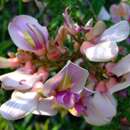fi
nimet breadcrumb-navigoinnissa


A native of Asia, Kudzu (Pueraria montana var. lobata) is among the most widespread and abundant invasive weeds in the eastern United States. Although its stronghold in North America is in the southeastern United States, its range extends into the northeastern and northcentral United States as well. The deciduous vines arise from massive perennial starchy root crowns, which can reach down to 4 m deep in the soil and weigh up to 136 kg. These massive roots provide energy for rapid initial growth in spring. Kudzu dies back to the ground after a hard freeze, but maximal growth rate in spring has been reported to be around 0.3 m per day and a plant may grow 20 to 30 m in a growing season. The fragrant purple flowers typically appear only on vines that are growing vertically on some support. Flowers occur on pseudoracemes, unusual inflorescences in which multiple flowers emerge from each bract axil.
Before Kudzu's invasive potential was recognized, it was repeatedly introduced into the southeastern United States for use as an ornamental and forage crop and for erosion control (Mitich 2000). Its subsequent rapid spread occurred despite conspicuously low seed set. Plants rarely flower before their third year and in some North American populations flowering is rarely if ever observed. In other areas, vines produce many flowers, but these often yield low numbers of seed pods or seed pods containing few seeds. In North America, many Kudzu populations sustain heavy losses to seed predators. Harvey (2009) documented the presence of extrafloral nectaries (EFNs) in Kudzu underneath the lateral floral peduncles. He speculated that documented herbivore-induced low seed set might result from a disruption of the protection normally afforded by ants attracted to EFNs. The atypical, near-monospecific stands of Kudzu in its introduced range may support a low diversity of ants or the ant species that typically visit Kudzu EFNs in its introduced range may not be as effective as those in its native range at finding or using the EFNs or are otherwise less effective as herbivore deterrents.
Kudzu is widely viewed as a seriously invasive plant in the United States, covering (often densely) over 1.2 to 2.8 million ha and this area has been estimated to be increasing on the order of 50,000 ha per year. Over time, Kudzu can cover large areas of potentially productive forest and farmland, resulting in estimated losses of $100 to 500 million per year. It is not yet clear what, if any, impact the recent arrival in the southeastern United States of the plataspid bug Megacopta cribraria (one of many herbivores feeding on Kudzu in Asia) may have on Kudzu (or other native and non-native hosts, including Soybean). If M. cribraria depletes Kudzu root reserves and reduces its ability to climb, this could benefit southern forests as well as farmers, utility companies, and railroads that must deal with Kudzu encroaching on their land, climbing utility poles, and growing across their tracks.
Kudzu is a common food crop in Java, Sumatra, and Malay, is well adapted to Puerto Rico, and grows in scattered parts of South America (Mitich 2000). Keung (2002) reviewed the entire genus Pueraria (which includes around 15 species).
(Mitich 2000 and references therein; Keung 2002; Harvey 2009 and references therein; Zhang et al. 2012 and references therein)